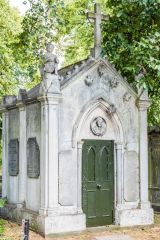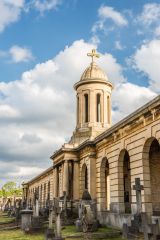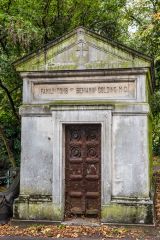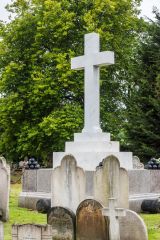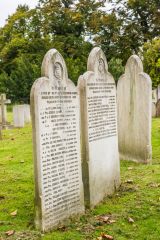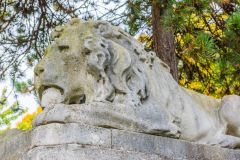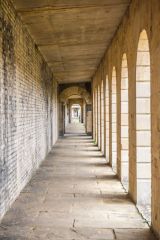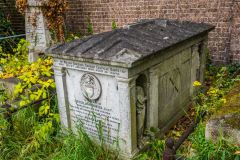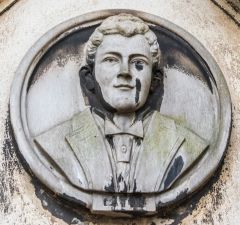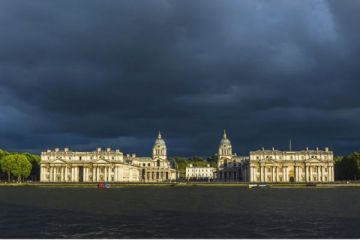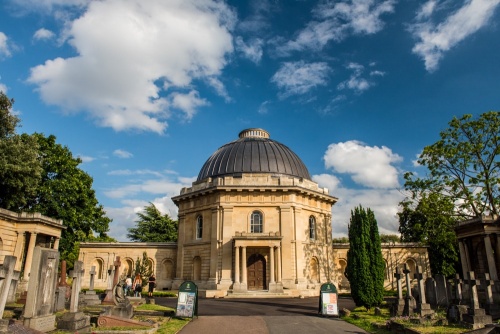
Brompton Cemetery is among the oldest garden cemeteries in Britain, a combination working cemetery, nature and wildlife refuge, garden, and historic site, with over 205,000 graves spread across 39 acres. There are over 35,000 memorials, of which 28 are listed for their historical importance. The cemetery was established in 1840 and is now managed by the Crown on behalf of the nation.
History
In the early decades of the 19th century, the population of London was expanding at a startling rate, as the Industrial Revolution drew new residents from across Britain. The number of residents doubled within 40 years, making London the largest city in the world.
That growth in population came at a cost, as the old burial grounds of London were, quite literally, full to bursting. To relieve the pressure on established churchyards in the city, a ring of new 'garden cemeteries' was erected outside the city centre.
These 'Magnificent Seven' burial grounds were not built as a public service; they were ambitious commercial projects aimed at drawing clientele from amongst the newly wealthy middle classes as well as the gentry. The burial grounds raised money by offering shares on the London stock market.
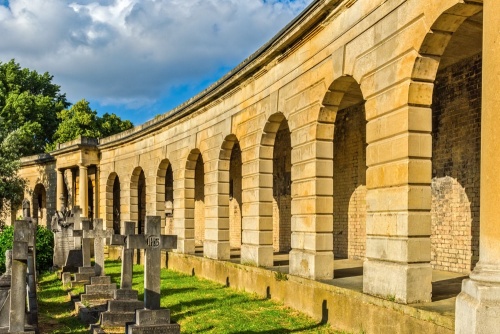
One of the Magnificent Seven was Brompton Cemetery, on the western border of the Royal Borough of Kensington and Chelsea. When the cemetery was built it was well outside the city, but over time London has expanded to engulf the burial ground.
The original plot of land was a slender half-mile long parcel between Fulham Road and Old Brompton Road. The Kensington Canal ran along the western boundary but sadly the canal was filled in to be replaced by the present railway line before the cemetery opened.
A design competition was launched under Sir Jeffry Wyatville, William IV’s ‘Surveyor of the Fabric’. Wyatville decided on a design submitted by one of his assistants, Benjamin Baud, which, not surprisingly, was similar to Wyatville's own work.
The initial cost estimate was £30,000, but before the cemetery had even opened it had cost £61,000. The cemetery was consecrated in June 1840, before construction was complete, and the first burial took place on 18 June.
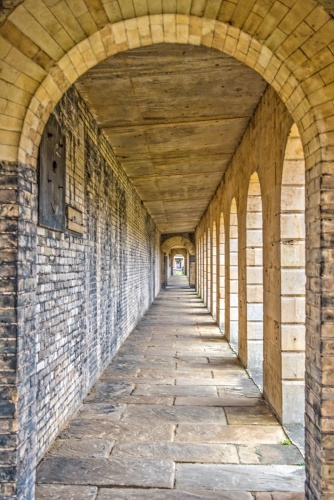
The Cemetery Design
Think of Brompton Cemetery as an open-air cathedral, with the broad Central Avenue running down the centre like the nave of a church. The Central Avenue runs 2000 feet to a spectacular domed chapel, acting as the altar of the 'cathedral' layout. It was originally lined with a double row of limes flanked by pine trees, but only the lime trees remain.
On its way to the Chapel, the Central Avenue crosses a huge Great Circle, 300 feet in diameter, inspired by the piazza of St Peter's Basilica in Rome.
Flanking the Great Circle and the Grand Avenue are two colonnades rising above catacombs entered by huge cast-iron doors. The western arcade boasts a bell tower (there was supposed to be a matching tower on the eastern arcade but this was never built due to cost overruns).
Baud's plans called for 'transept' formed by chapels for Catholics and Nonconformists. Religious prejudice made these chapels a low priority and they were eventually axed for financial reasons. There is a small chapel, originally meant for Church of England use but later rededicated for Nonconformists.
Fronting onto Old Brompton Road is the North Lodge and Gatehouse, acting as the great west door of the 'cathedral'.
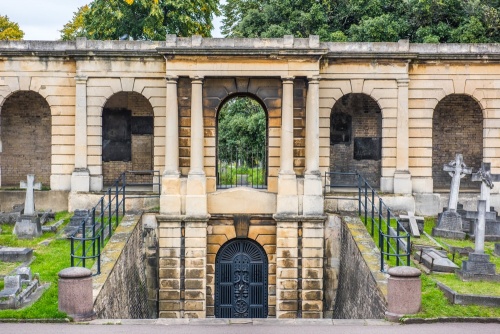
Private Graves
The design allowed for 60,000 grave plots, with private graves to the east and common graves to the west. Private graves were sold 'in perpetuity'; they could be passed from one generation to the next. This encouraged wealthy people to build an ornate family mausoleum over a burial vault, capable of holding generations of the same family. There are some 35,000 private graves, with monuments ranging from simple headstones to neoclassical mausolea on a grand scale.
Common graves, by contrast, saw up to 10 burials in a single deep grave, with no right to erect a headstone. These were not pauper's graves; the family of someone buried in a common grave still paid for the right.
Many of those buried in common graves at Brompton served in the military. From 1854-1939 Brompton was London District’s Military Cemetery, and the War Ministry usually buried servicemen in unmarked common graves. Once Brompton had been established as the official burial ground for service personnel, however, some branches of the military made special arrangements.
The Royal Hospital Chelsea (home to the Chelsea Pensioners) bought a plot in the north-west corner of Brompton Cemetery. They were followed by the Brigade of Guards and the Household Cavalry whose plots lie south of the Royal Hospital Chelsea one.
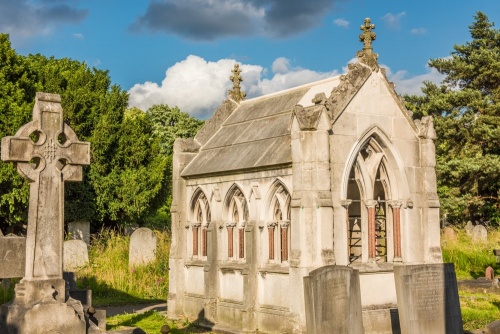
Money Woes
Not only had the cemetery doubled in cost before it had even opened, it wasn't getting the business the financial backers expected. The builder, Philip Nowell, had to loan money to the shareholders just so he could keep working. Then things got worse; structural defects appeared in major buildings. The architect blamed the builder, and the builder blamed the architect.
The company directors were in a bind, but since they owed so much money to Philip Nowell they took his side and fired Benjamin Baud.
Nationalising the Cemetery
The story of Brompton Cemetery took a bizarre turn in 1850 when Parliament passed the Metropolitan Interments Act, which stopped burials in overcrowded urban churchyards and gave the government the power of compulsory purchase over commercial cemeteries like Brompton.
The act was repealed just 2 years later in 1852 but not before the government had tendered an official offer. The government tried to withdraw the offer, but the shareholders of Brompton Cemetery were worried that they would lose their investment and insisted that the sale be finalised. They must have wished they hadn't when the final settlement was just £75,000, considerably less than the £169,000 they had claimed.
Brompton Cemetery was the only private cemetery purchased under the Metropolitan Interments Act of 1850, and the first cemetery in Britain to be nationalised. It is the only crown cemetery in the country and is maintained by the Royal Parks Agency, the same body that looks after higher-profile royal parks such as Hyde Park, Kensington Gardens, St James Park and Richmond Park.
Brompton Cemetery was closed in 1952 but reopened in 1996. It is a Grade I listed site but also contains a wealth of listed buildings, such as the colonnades, the chapel, and the entrance gates on Old Brompton Road. There are 26 listed monuments including one listed Grade II*, and the Chelsea Pensioners’ Monument, the Guards’ Memorial are also listed Grade II for their historic interest.
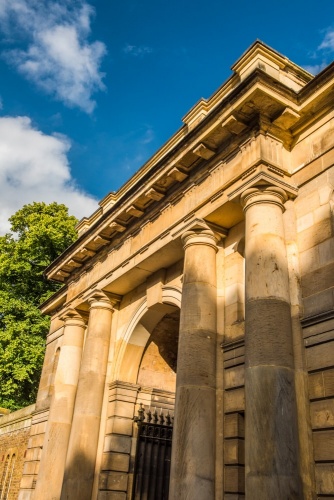
Historic Highlights
Central Avenue
This broad tree-lined avenue runs the length of the cemetery from the North Lodge gates to the Chapel. Central Avenue acted as the nave of the cemetery 'church'. The Central Avenue is over 2,000 feet long (800m) and is lined with lime trees grown in the cemetery's own nursery and planted in 1846. The lime trees act as a habitat for moth caterpillars, while bees are drawn to the flowers and birds roost in their branches.
North Lodge
The main entrance to the cemetery faces onto Old Brompton Road. The neoclassical entrance flanked by lodges was designed to make an impression on wealthy visitors considering the cemetery as a final resting place for their loved ones. Records were stored in the Lodge and staff controlled access through the gates. The Lodge now houses an exhibition on the cemetery's history as well as administration offices.
Great Circle and Colonnades
The centrepiece of Benjamin Baud's design for Brompton Cemetery, this wide circular space was inspired by the piazza in front of St Peter’s Basilica in Rome. Baud intended the Great Circle to be an open green space, a pleasant grassy lawn, but he reckoned without the shareholders' desire to make money. The Great Circle is now crammed with striking gravestones.
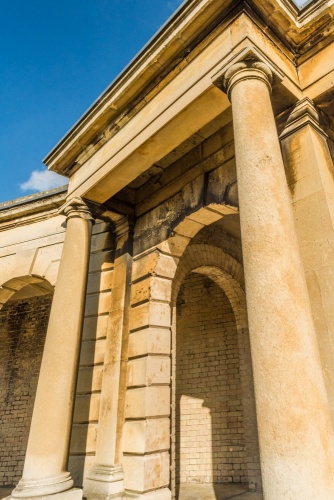
The Catacombs
If you were a wealthy Victorian but didn't want to spend the money for an expensive mausoleum on the Central Avenue, there was a stylish alternative; you could opt for an ornately decorated coffin on a shelf in the underground Catacombs, beneath the colonnades. This option allowed family members to visit the coffin regularly.
Benjamin Baud designed the Catacombs to hold thousands of burials but only 500 spaces were ever sold. The public may have been put off by public health warnings over the danger of lead coffins exploding under the pressure of gasses released by dead bodies. The Catacombs entrance gates are beautifully carved with figures of snakes curling around upside down torches.
The Chapel
Benjamin Baud's original design called for three chapels but only one was ever built. This exquisite domed building stands at the southern end of Central Avenue and is the focal point for Baud's design. The octagonal structure was meant to depict life on earth while the dome represents heaven. The Chapel is built of Bath stone and the dome is lined with lead. The dome is supported on eight Corinthian columns while the ceiling is carved with figures of acanthus leaves and marigolds.
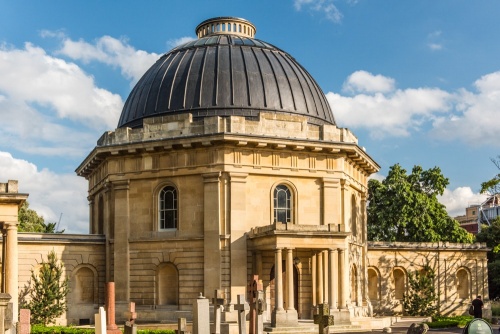
Famous Graves
John 'Gentleman' Jackson (1769-1845)
Jackson was a fearsome bare-knuckle boxer who was crowned Champion of England in 1795. When he retired Jackson set up a boxing academy on Bond Street, where he taught self-defence to the sons of the nobility. His most famous pupil was the poet Lord Byron. Jackson was selected to be a bodyguard to the king at the coronation of George IV in 1821.
He was accompanied by a band of prizefighters and together their formidable presence kept the crowd in order during the ceremony. His monument is topped by a large sculpture of a lion, paid for by public subscription. His funeral procession in 1845 stretched for miles and was attended by tens of thousands of mourners.
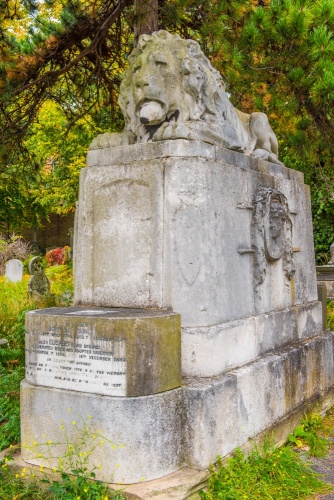
Emmeline Pankhurst (1858-1928)
One of the most visited graves in Brompton Cemetery is that of Emmeline Pankhurst, perhaps the most prominent campaigner for women's rights during the early part of the 20th century. Pankhurst founded the Women's Social and Political Union (WSPU) in 1903 and for the next 25 years waged a tireless - and at times violent - campaign for voting rights. She tragically died just three weeks before reforms giving women the vote became law.
Every time we have visited the cemetery there are fresh flowers at her grave, a reminder that Pankhurst remains a figure of inspiration for millions of women to this day.
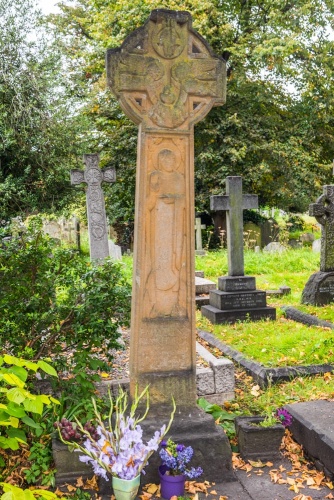
Brigade of Guards Monument (1889)
A marble cross marks the site where members of the Brigade of Guards who lost their lives during peacetime wee buried between 1854-1899. The cross base is carved with the badges of the Coldstream, Grenadier and Scots Guards - the three oldest Guards regiments. The monument includes pyramids of cannonballs and gun barrels carved from Portland stone. At the base of the cross are 18 white headstones, though there are several hundred Guardsmen buried here.
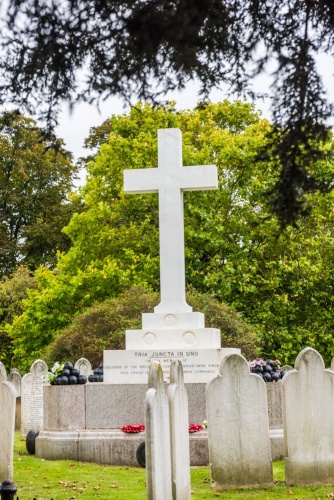
Chelsea Pensioners Monument (1901)
The Royal Hospital Chelsea is home to the Chelsea Pensioners, retired members of the British Army known for their distinctive red uniforms. When the Hospital's graveyard became full in 1854 they began using Brompton Cemetery. By 1898 some 2.625 ex-soldiers had been buried at Brompton, mainly in unmarked graves.
A newspaper article in 1898 pointed out that the Pensioners' graves were sadly neglected, and the ensuing public outcry prompted the Treasury to clean up the burial site and put forward money for a suitable memorial. It took two years for the monument to be erected, because Mr George Wyndham, the Undersecretary for War, was slow to write a suitable epitaph.
The memorial is in the form of a pink granite column of a grey granite plinth. At the foot of the column are four bronze lions. In each corner of the memorial enclosure are pyramids of cannonballs cast from gunmetal.
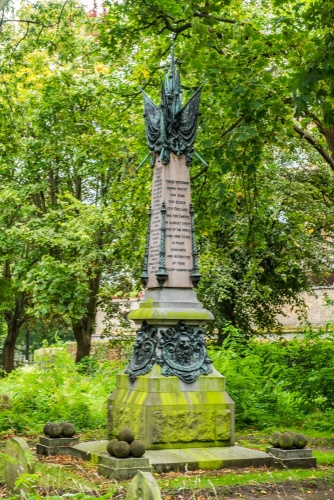
Blanche Roosevelt Macchetta (1853-1898)
In the Great Circle stands a lifelike statue of Italian marble commemorating Blanche Roosevelt Macchetta, an American opera singer and a distant relative of US President Teddy Roosevelt. She moved in the highest social circles; she was a close friend of the American poet Henry Wadsworth Longfellow and the Italian opera composer Guiseppe Verdi. She was also the mistress of the French writer Guy de Maupassant.
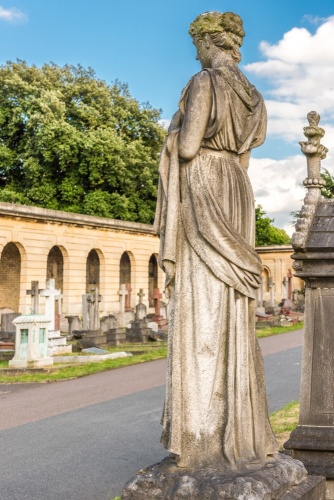
Metropolitan Anthony of Sourozh (1914-2003)
One of the most heavily visited graves in the cemetery is the resting place of André Borisovich Bloom, the head of the Russian Orthodox Patriarchal Church in Great Britain and Ireland. His grave is marked by a traditional three-bar Russian Orthodox cross.
Percy Pilcher (1867-1899)
Pilcher was an aviation pioneer who developed a powered aeroplane before the Wright brothers did, but he died in a tragic accident at Stanford Hall in Leicestershire before he could test his plane in public.
Fanny Brawne (1800-1865)
Fanny was the fiancee of poet John Keats, who tragically died of tuberculosis in 1821. Keats was inspired by her to write many of his most famous poems. Many years after Keats' death Fanny married a wealthy merchant named Louis Lindon and her gravestone bears the name Fanny Lindon as a result.
Iris Burnside (1894-1915)
In 1915 Iris Burnside embarked on a voyage to Liverpool aboard the Cunard passenger liner Lusitania. She was on her way to visit family in Ireland along with her mother and a maid. On 7 May the ship was torpedoed by a German U-boat off the Irish coast. Iris managed to board a lifeboat but perished along with 1,195 passengers and crew. The memorial names Iris and her brother Alan, though Alan is the only one buried here.
Dr John Snow (1813-1858)
Dr Snow proved that cholera was spread by infected drinking water, though his efforts were not widely accepted for several decades after his ground-breaking study. He also pioneered the safe use of anaesthetics in medical procedures. Queen Victoria called on him to administer anaesthesia for the births of two of her children. Dr Snow was voted as the greatest physician of all time by British doctors.
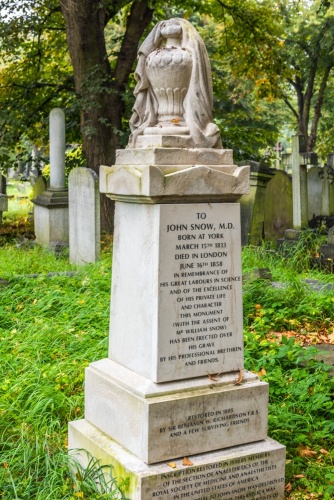
Emma Shaw (1816-1840)
The first person buried in Brompton Cemetery, under an unremarkable horizontal ledger stone. Shaw was married to the artist Charles Boyle Shaw and lived Portland Place in Fulham. Emma died in childbirth in 1840.
John Wisden (1826-1884)
Sports fans will need no introduction to the name Wisden. John Wisden was a professional cricketer who remains the only man ever to have bowled out all ten opposing batsmen in a first-class innings. His sporting feats aside, Wisden is best remembered for publishing the Wisden Cricketer’s Almanack. The first issue of the Almanack came out in 1864 and it remains the most influential and prestigious cricket publication to this day.
Getting There
The cemetery is extremely easy to reach. West Brompton underground (District Line) and overground rail station is just two minutes away. From the station exit turn right and walk along Old Brompton Road to the cemetery's north gates.
The Friends of Brompton Cemetery also offer regular guided tours of the site. Check the Friends' website for dates and times.
The cemetery is open daily, with shorter hours in winter.
About Brompton Cemetery
Address: Old Brompton Road,
London,
Greater London,
England, SW10 9UG
Attraction Type: Landmark
Location: North Lodge entrance on Old Brompton Road, a two-minute walk from West Brompton tune and rail station.
Website: Brompton Cemetery
Royal Parks
Location
map
OS: TQ257776
Photo Credit: David Ross and Britain Express
Nearest station: ![]() West Brompton - 0.3 miles (straight line) - Zone: 2
West Brompton - 0.3 miles (straight line) - Zone: 2
HERITAGE
 We've 'tagged' this attraction information to help you find related historic attractions and learn more about major time periods mentioned.
We've 'tagged' this attraction information to help you find related historic attractions and learn more about major time periods mentioned.
Find other attractions tagged with:
NEARBY HISTORIC ATTRACTIONS
Heritage Rated from 1- 5 (low to exceptional) on historic interest
Lindsey House - 0.7 miles (Historic Building) ![]()
Chelsea Old Church (All Saints) - 0.8 miles (Historic Church) ![]()
Carlyle's House - 0.9 miles (Historic Building) ![]()
Albert Bridge - 1 miles (Landmark) ![]()
Natural History Museum - 1 miles (Museum) ![]()
Clockmakers' Museum - 1.1 miles (Museum) ![]()
Science Museum - 1.1 miles (Museum) ![]()
Chelsea Physic Garden - 1.1 miles (Garden) ![]()
Nearest Holiday Cottages to Brompton Cemetery:
Leaves Green, Greater London
Sleeps: 6
Stay from: £871 - 3127
Holmbury St Mary, Surrey
Sleeps: 9
Stay from: £855 - 4619
More self catering near Brompton Cemetery
